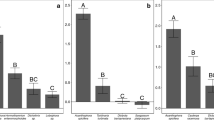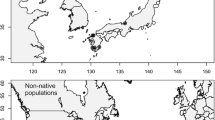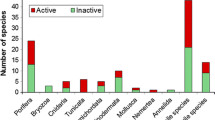Abstract
We sought to determine whether common intertidal and shallow subtidal zone grazers would consume extracts or fronds of three invasive Caulerpa spp., all of which are now resident in southern New South Wales, Australia. We examined the responses of herbivorous fishes, echinoderms and molluscs to C. filiformis. A subset of these organisms was tested with extracts of C. scalpelliformis and C. taxifolia. Polar (seawater) extracts of C. filiformis deterred a single herbivore, Aplysia sydneyensis, but confirmed that the biological activity reported from some Caulerpa spp. is not restricted to the lipophilic fractions. The large turbinid Turbo torquatus was deterred by an ethanol extract of C. filiformis, while the small congener T. undulatus demonstrated a significant preference for palatable agar discs containing ethanol extracts of C. filiformis. However, when T. undulatus were offered a choice of fronds from five algal species in the laboratory, they readily consumed Ulva spp. and Sargassum sp., showing the lowest preference for C. filiformis. Solvent extracts of C. scalpelliformis and C. taxifolia did not significantly deter any grazers. However, the overall trend was for reduced consumption of discs containing solvent extracts of these seaweeds. Indeed, for the large urchin Centrostephanus rodgersii and in the fish trials these effects were very near significant (P<0.06). We conclude that common herbivores associated with hard substrata are highly unlikely to intercede in the spread or control of these invasive algae.







Similar content being viewed by others
References
Agrawal AA, Kotanen PM (2003) Herbivores and the success of exotic plants: a phylogenetically controlled experiment. Ecol Lett 6:712–715
Andrew NL (1993) Spatial heterogeneity, sea urchin grazing, and habitat structure on reefs in temperate Australia. Ecology 74:292–302
Andrew NL, Jones GP (1990) Patch formation by herbivorous fish in a temperate Australian kelp forest. Oecologia 85:57–68
Ayling AL (1978) The relation of food availability and food preferences to field diet of an echinoid Evechinus chloroticus (Valenciennes). J Exp Mar Biol Ecol 33:223–235
Boudouresque CF, Lemee R, Mari X, Meinesz A (1996) The invasive algae Caulerpa taxifolia is not a suitable diet for the sea urchin Paracentrotus lividus. Aquat Bot 53:245–250
Calvert HE, Dawes CJ, Borowitzka MA (1976) Phylogenetic relationships of Caulerpa (Chlorophyta) based on comparative chloroplast ultrastructure. J Phycol 12:149–162
Carlton JT, Geller JB (1993) Ecological roulette: the global transport of nonindigenous marine organisms. Science 261:78–82
Chang GC, Kareiva P (1999) The case of indigenous generalists in biological control. In: Hawkins BA, Cornell HV (eds) Theoretical approaches to biological control. Cambridge University Press, Cambridge, pp 13–115
Clarke B, Murray J, Johnson MS (1984) The extinction of endemic species by a program of biological control. Pacif Sci 38:97–104
Conover WJ (1999) Practical nonparametric statistics. Wiley, New York
Crawley MJ (1996) Plant ecology. Blackwell, Oxford
Creese RG, Davis AR, Glasby TM (2004) Eradicating and preventing the spread of the invasive alga Caulerpa taxifolia in NSW. Final report to the Natural Heritage Trust’s coast and clean seas introduced marine pests program, project no. 35593. NSW Fisheries Final Report no. 64 (available at http://www.fisheries.nsw.gov.au/sci/outputs/aqua_sust/466_Crease.htm)
Cronin G, Hay ME (1996) Susceptibility to herbivores depends on recent history of both the plant and aninmal. Ecology 77:1531–1543
Davis AR, Roberts DE, Cummins SP (1997) Rapid invasion of a sponge-dominated deep-reef by Caulerpa scalpelliformis (Chlorophyta) in Botany Bay, New South Wales. Aust J Ecol 22:146–150
Davis AR, Fyfe SK, Turon X, Uriz MJ (2003) Size matters sometimes: wall height and the structure of subtidal benthic invertebrate assemblages in southeastern Australia and Mediterranean Spain. J Biogeogr 30:1797–1807
de Villele X, Verlaque M (1995) Changes and degradation in a Posidonia oceanica bed invaded by the introduced tropical alga Caulerpa taxifolia in the north western Mediterranean. Bot Mar 38:79–87
Dodd AP (1940) The biological campaign against prickly-pear in Australia. Commonwealth Prickly Pear Board, Brisbane
Dumay O, Pergent G, Pergent-Martini C, Amade P (2002) Variations in caulerpenyne contents in Caulerpa taxifolia and Caulerpa racemosa. J Chem Ecol 28:343–352
Edgar GJ (1997) Australian marine life: the plants and animals of temperate waters. Reed, Victoria, Australia
Edwards A (2002) Fauna associated with Caulerpa spp.; potential biological control of C. taxifolia. Honours thesis, Department of Biological Sciences, University of Wollongong, Wollongong, Australia
Fletcher WJ (1987) Interactions among subtidal Australian sea urchins, gastropods and algae: effects of experimental removals. Ecol Monogr 57:89–109
Guerriero A, Meinesz A, D’Ambrosio M, Pietra F (1992) Isolation of toxic and potentially toxic sesqui- and monoterpenes from the tropical green seaweed Caulerpa taxifolia which has invaded the region of Cap Martin and Monaco. Helv Chim Acta 75:689–695
Guerriero A, Marchetti F, D’Ambrosio M, Senesi S, Dini F, Pietra F (1993) New ecotoxicologically and biogenetically relevant terpenes of the tropical green seaweed Caulerpa taxifolia which is invading the Mediterranean. Helv Chim Acta 76:855–864
Hay ME (1984) Predictable spatial escapes from herbivory: How do these affect the evolution of herbivore resistance in tropical marine communities? Oecologia 64:396–407
Hay ME, Colburn T, Downing D (1983) Spatial and temporal patterns in herbivory on a Caribbean fringing reef: the effects on plant distribution. Oecologia 58:299–308
Jousson O, Pawlowski J, Zaninetti L, Zechman FW, Dini F, Di Guiseppe G, Woodfield R, Millar A, Meinesz A (2000) Invasive alga reaches California. Nature 408:157
Keane RM, Crawley MJ (2002) Exotic plant invasions and the enemy release hypothesis. Trends Ecol Evol 17:164–170
Komatsu T, Ishikawa T, Yamaguchi N, Hori Y, Ohba H (2003) But next time? Unsuccessful establishment of the Mediterranean strain of the green seaweed Caulerpa taxifolia in the Sea of Japan. Biol Invasions 5:275–278
Lemée R, Pesando D, Durand-Clément M, Dubreuil A, Meinesz A, Guerriero A, Pietra F (1993) Preliminary survey of toxicity of the green alga Caulerpa taxifolia introduced into the Mediterranean. J Appl Phycol 5:485–493
Lucas AHS (1927) Notes on the Australian marine algae. V. Proc Linn Soc NSW 52:555–562
Maron JL, Vilà M (2001) When do herbivores affect plant invasion? Evidence for the natural enemies and biotic resistance hypotheses. Oikos 95:361–373
May V (1976) Changing dominance of an algal species (Caulerpa filiformis (Suhr) Hering). Telopea 1:135–138
Meinesz A (1999) Killer algae. University of Chicago Press, Chicago
Meinesz A, de Vaugelas J, Hesse B, Mari X (1993) Spread of the introduced tropical green alga Caulerpa taxifolia in northern Mediterranean waters. J Appl Phycol 5:141–147
Meinesz A, Belsher T, Thibaut T, Antolic B, Mustapha KB, Boudouresque CF, Chiaverini D, Cinelli F, Cottalorda J-M, Djellouli A, El Abed A, Orestano C, Grau Antoni M, Ivesa L, Jaklin A, Langar H, Massuti-Pascual E, Peirano A, Tunesi L, de Vaugelas J, Zavodnik N, Zuljevic A (2001) The introduced green alga Caulerpa taxifolia continues to spread in the Mediterranean. Biol Invasions 3:201–210
Meyer KD, Paul VJ (1992) Intraplant variation in secondary metabolite concentration in three species of Caulerpa (Chlorophyta: Caulerpales) and its effects on herbivorous fishes. Mar Ecol Prog Ser 82:249–257
Paul VJ, Fenical W (1986) Chemical defense in tropical green algae, order Caulerpales. Mar Ecol Prog Ser 34:157–169
Paul VJ, Fenical W (1987) Natural products chemistry and chemical defence in tropical marine algae of the phylum Chlorophyta. In: Scheuer PJ (ed) Bioorganic marine chemistry. Springer, Berlin, pp 1–29
Paul VJ, Hay ME (1986) Seaweed susceptibility to herbivory, chemical and morphological correlates. Mar Ecol Prog Ser 33:255–264
Paul VJ, Littler MM, Littler DS, Fenical W (1987) Evidence for chemical defense in tropical green algae Caulerpa ashmeadii (Caulerpaceae: Chlorophyta): isolation of bioactive sesquiterpenoids. J Chem Ecol 13:1171–1185
Paul VJ, Cruz-Rivera E, Thacker RW (2001) Chemical mediation of macroalgal–herbivore interactions: ecological and evolutionary perspectives. In: McClintock JB, Baker BJ (eds) Marine chemical ecology. CRC Press, Boca Raton, Fla., USA, pp 227–265
Peterson CH, Renaud PE (1989) Analysis of feeding preference experiments. Oecologia 80:82–86
Piazzi L, Balestri E, Cinelli F (1994) Presence of Caulerpa racemosa in the north-western Mediterranean. Cryptogam Algol 15:183–189
Pillman A, Woolcott GW, Olsen JL, Stam WT, King RJ (1997) Inter- and intraspecific genetic variation in Caulerpa (Chlorophyta) based on nuclear rDNA ITS sequences. Eur J Phycol 32:379–386
Roa R (1992) Design and analysis of multiple-choice feeding-preference experiments. Oecologia 89:509–515
Sanderson JC (1997) Subtidal macroalgal assemblages in temperate Australian coastal waters, Australia. State of the Environment Technical Paper Series (Estuaries and the Sea), Department of the Environment, Canberra
Sant N, Delgado O, Rodriguez-Prieto C, Ballesteros E (1996) The spreading of the introduced seaweed Caulerpa taxifolia (Vahl) C. Agardh in the Mediterranean Sea: testing the boat transportation hypothesis. Bot Mar 39:427–430
Secord D (2003) Biological control of marine invasive species: cautionary tales and land-based lessons. Biol Invasions 5:117–131
Smith CM, Walters LJ (1999) Fragmentation as a strategy for Caulerpa species: fates of fragments and implications for management of an invasive weed. Mar Ecol 2:307–319
Steinberg PD (1988) Effects of quantitative and qualitative variation in phenolic compounds of feeding in three species of marine invertebrate herbivores. J Exp Mar Biol Ecol 120:221–237
Steinberg PD, van Altena I (1992) Tolerance of marine invertebrate herbivores to brown algal phlorotannins in temperate Australasia. Ecol Monogr 62:189–222
Thibaut T, Meinesz A (2000) Are the Mediterranean ascoglossan molluscs Oxynoe olivacea and Lobiger serradifalci suitable agents for a biological control against the invading tropical alga Caulerpa taxifolia? C R Acad Sci Ser III Life Sci 323:477–488
Thibaut T, Meinesz A, Amade P, Charrier S, DeAngelis K, Ierardi S, Mangialajo L, Melneck J, Vidal V (2001) Elysia subornata (Mollusca) a potential control agent of the alga Caulerpa taxifolia (Chlorophyta) in the Mediterranean Sea. J Mar Biol Assoc UK 81:497–504
Trowbridge CD (1995) Establishment of the green alga Codium fragile ssp. tomentosoides on New Zealand rocky shores: current distribution and invertebrate grazers. J Ecol 83:949–965
Trowbridge CD (2004) Emerging associations on marine rocky shores: specialist herbivores on introduced macroalgae. J Anim Ecol 73:294–308
Trowbridge CD, Todd CD (2001) Host–plant change in marine specialist herbivores: ascoglossan sea slugs on introduced macroalgae. Ecol Monogr 71:219–243
Van Driesche RG, Bellows Jr TS (1996) Biological control. Chapman and Hall, New York
Williamson M (1996) Biological invasions. Chapman and Hall, New York
Worthington DG, Fairweather PG (1989) Shelter and food interactions between Turbo undulatum (Archaeogastropoda, Turbinidae) and coralline algae on rocky seashores in New South Wales, Australia. J Exp Mar Biol Ecol 129:61–80
Wright JT, Benkendorff K, Davis AR (1997) Habitat associated differences in temperate sponge assemblages: the importance of chemical defence. J Exp Mar Biol Ecol 213:199–213
Wright JT, de Nys R, Steinberg PD (2000) Geographic variation in halogenated furanones from the red alga Delisea pulchra and associated herbivores and epiphytes. Mar Ecol Prog Ser 207:227–241
Zar JH (1999) Biostatistical analysis, 4th edn. Prentice Hall, Engelwood Cliffs, N.J., USA
Zuljevic A, Thibaut T, Elloukal H, Meinesz A (2001) Sea slug disperses the invasive Caulerpa taxifolia. J Mar Biol Assoc UK 81:343–344
Acknowledgements
We acknowledge the assistance of D. Barker at NSW Fisheries for allowing access to their seawater facility. S. Fyfe and J. Wright improved early drafts of this manuscript. All algae and invertebrates for this study were collected under NSW Fisheries permit F265. This work was undertaken with financial assistance from the Institute for Conservation Biology, University of Wollongong. This is contribution number 252 from the Ecology and Genetics Group, University of Wollongong.
Author information
Authors and Affiliations
Corresponding author
Additional information
Communicated by M.S. Johnson, Crawley
Rights and permissions
About this article
Cite this article
Davis, A.R., Benkendorff, K. & Ward, D.W. Responses of common SE Australian herbivores to three suspected invasive Caulerpa spp.. Marine Biology 146, 859–868 (2005). https://doi.org/10.1007/s00227-004-1499-z
Received:
Accepted:
Published:
Issue Date:
DOI: https://doi.org/10.1007/s00227-004-1499-z




